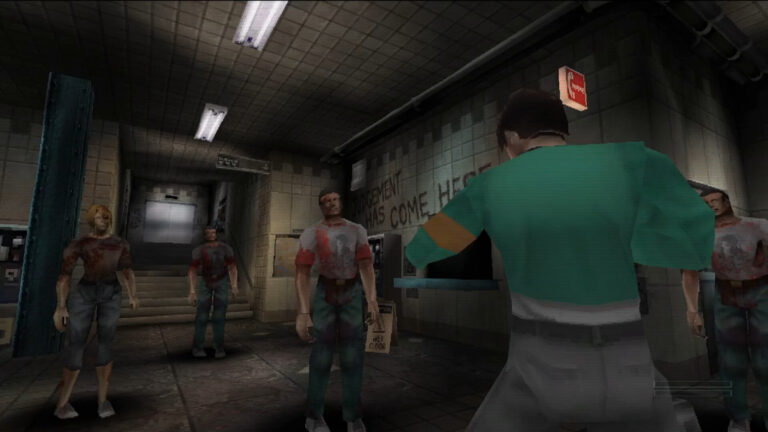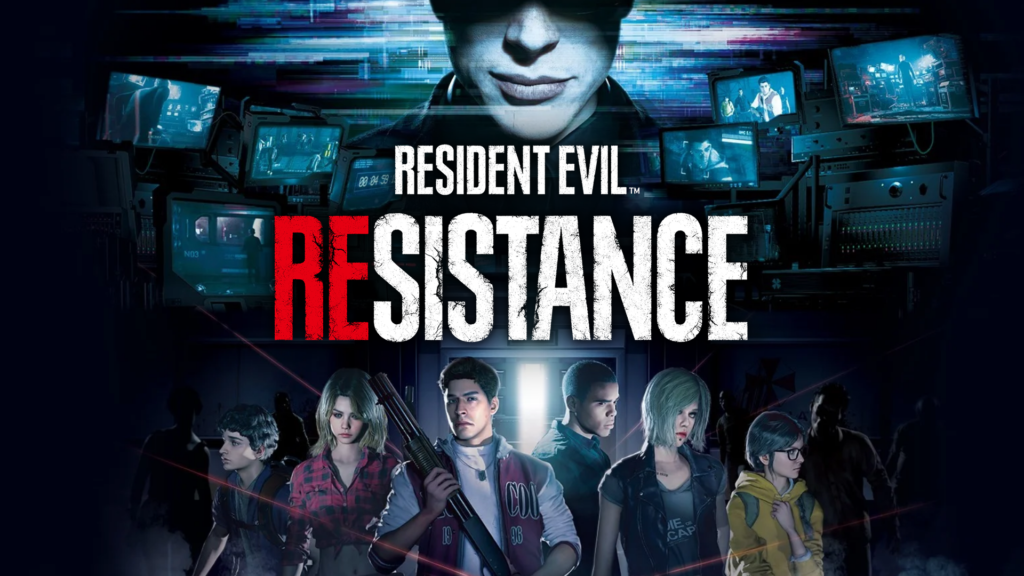
Note: This review only pertains to Resident Evil: Resistance and not Resident Evil 3 Remake. You can read our review of that here.
Well, here we are — finally! Existing in Resident Evil 3 Remake‘s shadow, many have already been quick to set aside Resident Evil: Resistance, the pack-in title that served as a bait and switch in early marketing for the latest remake. When first revealed as simply Project REsistance, I was cautiously optimistic, but I’ll admit the idea of yet another weird multiplayer spin-off in this series was questionable. In general, versus multiplayer in Resident Evil, be it massive flops like Umbrella Corps or even the Versus Mode DLC for Resident Evil 5, has never really been my cup of tea. Co-op tends to be a real highlight, but facing off against another player has often felt off-balance, or rather, lacking in what makes modern versus game design fun. Now that I have Resident Evil: Resistance in my hands, what do I think of it? Well, to be perfectly honest — I love it.
From the word go, I was instantly taken in by Resident Evil: Resistance‘s apparent disinterest in the ultra-serious tones of Umbrella Corps and Operation Raccoon City, aiming for something more akin to a parody of ’80s slashers and Resident Evil as a franchise. Every Survivor character operates in their own cliche niche, from the pompous jock to the frittering and jumpy bookworm, everyone here brings something incredibly simple but fresh to the table. This care-free, jokey attitude extends to the Masterminds (the solo antagonist player character) as well — from both returning villains like Alex Wesker and Annette Birkin to the new character Daniel Fabron (who I’ve taken a particular shine to). Resident Evil: Resistance wears a heap-full of charm on its sleeve. It’s hard not to crack a smile at the majority of the game’s dialogue.
Gameplay-wise, the two perspectives (despite not being anything like one another) are surprisingly solid, offering vastly different experiences that both challenge and reward. As a Survivor, you’re plopped into a more arcade-y interpretation of the Resident Evil 2 remake‘s gameplay, where you can’t wiggle your way out of damage — but you can let out a shout that makes everyone around you gain increased defense. Each of the (at the time of writing) seven Survivors come with their own abilities that vastly separate them from one another, and each has equipable perks even beyond their character-specific powers. Each character class leans on the others, with none being able to dominate a match on their own. Mixing and matching the seven Survivors into different combinations can result in wildly different match outcomes. Having January on your team to hack into the Mastermind’s cameras is a great tool to use in a pinch, but so is Valerie’s team heal ability. Tyrone’s “Mighty Foot” kick is great for clearing one or two zombies (at the cost of a very short cooldown), but it has limited use compared to Martin’s Flash Baton ability (which can blind an entire crowd of creatures but has a much longer cooldown). Team balance is something to always keep in mind when choosing your Survivor.
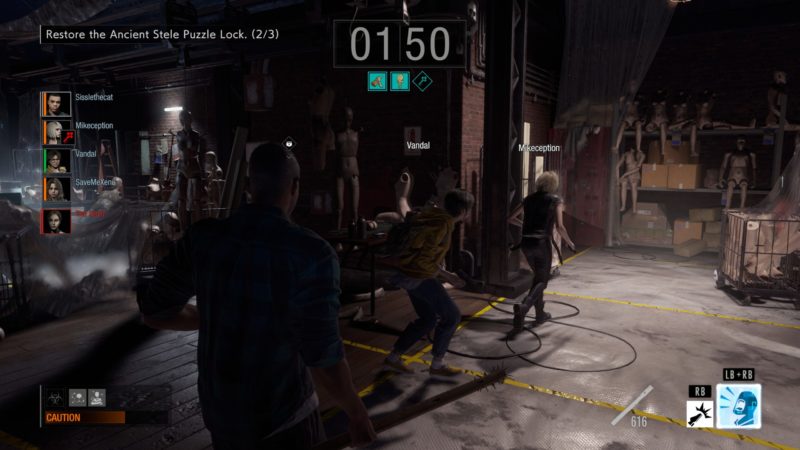
Timing the use of your abilities for just the right moment can be incredibly invigorating, especially when the Mastermind thinks they have one over on you. So many matches had ended when my team managed to coordinate and pace out the use of abilities to give us total domination over the smack-talking villain behind the camera — and those victories have been ever so sweet. Of course, an arrant teammate getting lost on the map or struggling to figure out a character they’re not used to yet can drag your progress down significantly, as taking damage cuts into your remaining time (death doubly so). The more you play, however, the more you’ll begin to master each map’s potential item placement and pace. It’ll be interesting to see what Resident Evil: Resistance feels like in a few months when most of the player base will be well seasoned with the rules and layout of each map.
Playing as the Mastermind, on the other hand, is an entirely new and unique experience within the franchise. Observing the action from behind a series of cameras, the Mastermind plots out and anticipates players — pulling from a hand of “cards,” which allow them to place enemies and other obstacles in the Survivors’ path. Each card costs a certain amount of energy, which the Mastermind builds up over time. Spamming the Survivors with enemies and traps might seem like the best route to go, but a well-prepared team can easily wipe out what you thought was an insurmountable defense — leaving you waiting while your points recharge. Having complete access to the map and the placement of each puzzle piece allows you to plan and anticipate what the Survivors could do and what they’re probably going to do. It requires a certain amount of three-dimensional thinking that creates a much slower-paced, more pragmatic approach. Sometimes it’s better to lie in wait, rather than to spring forward and attempt to overwhelm off the bat.
As the Mastermind, you also have the ability to take direct control of certain undead enemies, and it’s a blast. The idea has been tried before, most notably in RE6, but I was not a fan of its implementation. RE6‘s zombies moved too slow and were too easily defeated. In Resident Evil: Resistance, however, the Mastermind-controlled zeds receive a buff to both speed and health. This change bestows more visceral attacks than the undead AI could ever bring. That said, taking direct control of zombies, while fun and giving the opportunity to conflict severe damage, also leaves you unable to place down new enemies and traps until you’re either defeated or stop controlling the monster. It’s a dangerous gamble, and cunning Survivors may be able to use your sudden lack of omnipresence to make some easy progress while you shamble around. That said, the Mastermind slowly builds up an Ultimate Card in the midst of all this, and when the Ult is fully charged, that’s when the heat turns up.
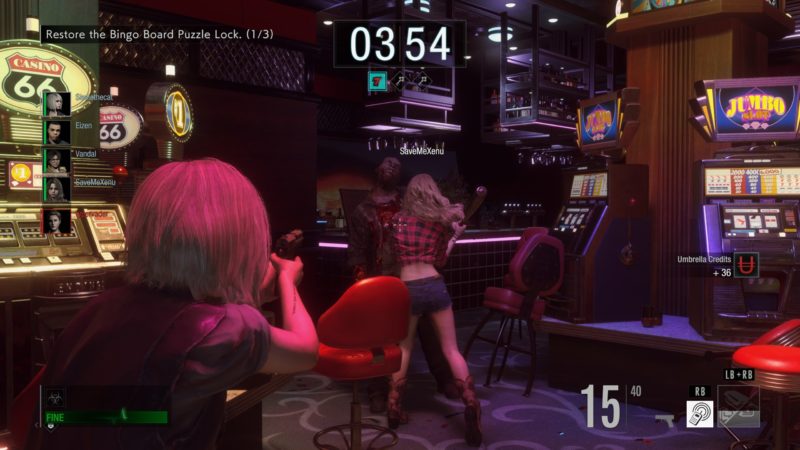
Forced to take direct control when unlocked (as there is no AI for these creatures), the Mastermind deploys a B.O.W., a massive beast that can wipe out a team of even the best-prepped Survivors in seconds. From the towering Frankenstein’s monster of Mr. X taking quick and powerful swings that can lay multiple Survivors flat out on their ass, to the lumbering behemoth of William Birkin (aka G), these monstrosities are crazy fun to control. Alex brings in an all-new B.O.W., the Yateveo — inspired by the likes of Plant 42 and the Audry II, this fleshy plant beast can grapple your teammates from across the room and devour them if they’re unable to break free in time. Spencer is perhaps the one Mastermind who’s ultimate falls strangely short, throwing up a laser grid that instantly downs any players who come into contact with it. It’s a powerful tool to be sure, but not exactly “fun.” Too many times, the Survivors catch wind of what Spencer is doing beforehand and end up just sitting and staring at the laser fence until it runs its course.
All that said, playing your cards right (literally) and timing the use of your abilities for just the right moment can be incredibly thrilling, especially when the Survivors think they have one over on you. So many matches have come to an end because a team’s coordination mattered little to my final few aces. Dropping in a strategically-placed B.O.W. to obliterate their small band of insolent little children — those victories have been ever so sweet.
See what I’m getting at? From both sides of the fight, Survivor and Mastermind, I’ve been amazed at how satisfying playing each team can be, despite all signs pointing towards the other having the ability to mess you up totally. Is January hacking your camera? Let her, swap to a camera behind her and spawn an Ivy. The Mastermind spawned Mr. X right behind you? Lead him onto one of the platform elevators and send him up, watching him pathetically ascend with nothing left to do but watch or disengage from control. The gameplay itself is so varied and exciting that I found the missions (which are always the same three objectives no matter which map) barely mattered in the face of how different each match could go depending on the ingenuity of the Survivors and the Mastermind.
The four available maps at launch are wildly different from each other, and each features a fun and unique theme. From a semi-functional but none the less abandoned dark ride in an amusement park to a Casino that leads into a gaudy strip club, I found all to be entertaining and delightfully detailed. The amusement park is especially enjoyable to explore, but that may be due to my own love for that kind of setting to begin with.
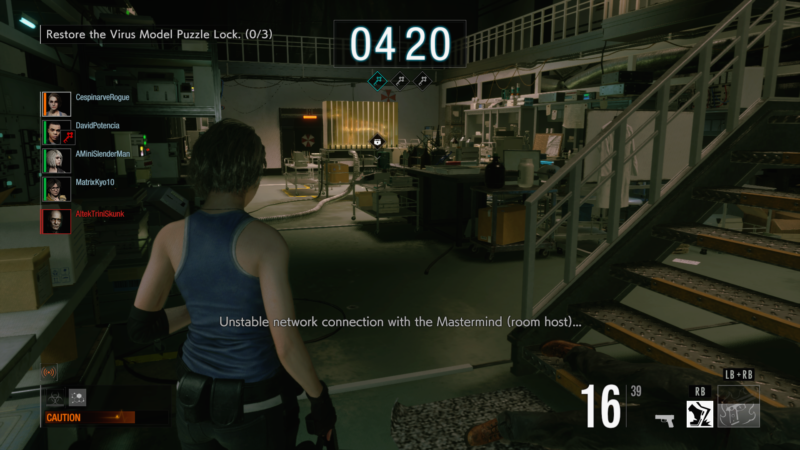
While all of those positives are my main takeaways from Resident Evil: Resistance, I’d be remiss not to go over the negatives, of which there are quite a few. While there are a handful of balance issues (ex. Mr. X needs a serious cooldown between punches), the game design itself isn’t the problem — the technical side of the experience is. Chiefly, Resistance works off of peer-to-peer networking, rather than dedicated servers. Survivor players connect to the Mastermind’s host network, which creates several problems, including weird lag issues as well as a persistent “Unstable Network Connection” notification that I think has been onscreen for almost every match I’ve played. Lag can be a massive issue, especially when using certain weapons and special moves. The shotgun, in particular, can have a difficult time registering damage, and Jill’s dodge ability doesn’t hold up well either.
Another issue is queuing up to find other players is an abject nightmare. Wait times can range wildly from a minute to ten minutes, and there doesn’t seem to be any rhyme or reason to it — and attempting to play as Mastermind increases that wait tenfold. It’s a massive thorn in the side of the experience, and I desperately hope some sort of workaround is achieved soon. This problem is amplified by the fact that the queue screen is the most boring god damn thing to look at since the launch loading screen for Bloodborne.
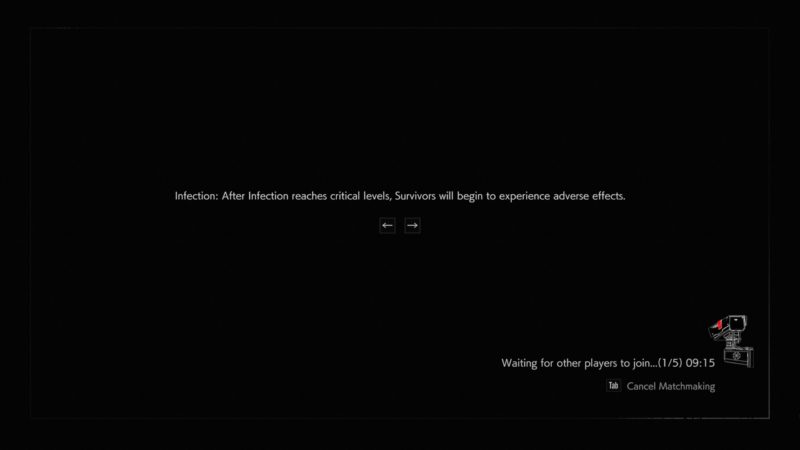
There’s also a strange lack of many elements that are fundamental aspects to most multiplayer experiences. There’s no way to check your stats in-game (requiring you to go to the RE.Net website separately), and many of the UI elements both in and out of gameplay are cramped and unappealing. Trying to sort through cosmetics for each Survivor (as you have to equip them one at a time) is exhausting, and it really shouldn’t be. Speaking of the UI, the inventory menu in-game is weirdly… sticky? I’m not sure how else to describe it, but it’s difficult to pop in and out of it compared to pretty much any other game in the series, and it can trip me up from time to time when just trying to grab something from it quickly and get back to the action. There are noticeable dead spots in regards to the timing of the game menu where you simply cannot close it. This odd pause makes using recovery items practically suicidal as you’re locked in place when in the menu (whereas using them from the directional pad quick-access can still be done while moving).
Resident Evil: Resistance also utilizes a loot box system (because of course it does) but at least you can’t pay for them. Each box, from Mastermind and Survivor loadout items that increase stats to character cosmetics, can only be purchased with in-game points you earn just by playing. That said, you can purchase point boosters, which multiply how many points you earn per match. Interestingly, it also affects players in your team that haven’t purchased these boosters, which is pretty neat. Honestly, though, I’m not sure that they make that much difference. Similar to the Life Crystal thing Revelations 2 had, you earn enough XP through normal play to get by just fine. Increasing the number of cosmetics dropped would be appreciated, though, since it has the Overwatch problem that 90% of most things you get are sprays or skins for weapons you’ll barely even able to see.
Once Resistance‘s kinks are worked out and matchmaking improved, I think Capcom and developer NeoBards’ will have something truly special on their hands. I finally have a versus Resident Evil multiplayer title that I genuinely enjoy; I’ve had a great time playing it, having already sunk nearly 5x as much time into it as I did with the Resident Evil 3 remake. I can’t wait to see what the DLC brings, and I genuinely hope Resident Evil: Resistance receives support for years to come.
 (8.5 / 10)
(8.5 / 10)
Great
 (8.5 / 10)
(8.5 / 10)Rely on Horror Review Score Guide
A Steam review copy of the game was provided by the publisher.

